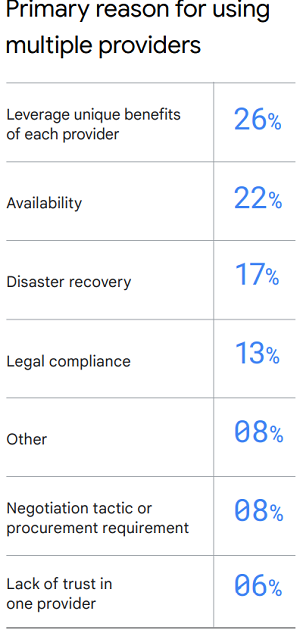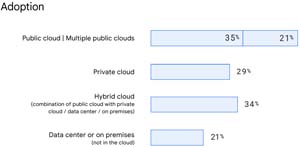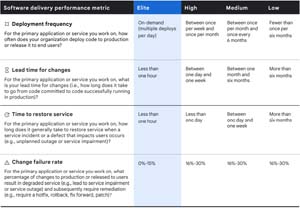News
Report: DevOps Goes Multi-Cloud to Enjoy 'Unique Benefits' of Multiple Providers
It's no secret that organizations are moving more to multi-cloud implementations for multiple reasons. For DevOps teams, that reason being the ability to leverage unique benefits provided by multiple providers.
That's one of the takeaways found in the "Accelerate State of DevOps Report" from Google, specifically the DevOps Research and Assessment (DORA) team at Google Cloud.
In a survey of some 1,200 professionals around the world, the primary reason for using multiple providers was "Leverage unique benefits of each provider," reported by 26 percent of respondents.
"Every cloud provider provides basic compute and storage services, but building a best-in-class business can be best achieved by taking advantage of best-in-class cloud computing features and not being locked into a specific vendor," Google said in a blog post last month announcing the report.
 [Click on image for larger view.] Primary Reason for Using Multiple Providers (source: Google Cloud).
[Click on image for larger view.] Primary Reason for Using Multiple Providers (source: Google Cloud).
The actual report itself provides more context about the No. 1 answer.
"This suggests that when respondents select an additional provider, they look for differentiation between their current provider and alternatives. The second most common reason for moving to multi-cloud was availability (22 percent). Unsurprisingly, respondents who have adopted multiple cloud providers were 1.5 times as more likely to meet or exceed their reliability targets."
That more and more organizations are moving to the new multi-cloud normal (and hybrid cloud) is beyond doubt, as the new survey reaffirms.
 [Click on image for larger view.] Cloud Adoption (source: Google Cloud).
[Click on image for larger view.] Cloud Adoption (source: Google Cloud).
"Consistent with Accelerate State of DevOps 2019, an increasing number of organizations are choosing multi-cloud and hybrid cloud solutions," the report said. "In our survey, respondents were asked where their primary service or application was hosted, and public cloud usage is on the rise. 56 percent of respondents indicated using a public cloud (including multiple public clouds), a 5 percent increase from 2019. This year we also asked specifically about multi-cloud usage, and 21 percent of respondents reported deploying to multiple public clouds. 21 percent of respondents indicated not using the cloud, and instead used a data center or on-premises solution. Finally, 34 percent of respondents report using a hybrid cloud and 29 percent report using a private cloud."
Of course, DevOps practices are at the heart of the expansive survey report, as several of the key takeaways provided by Google Cloud show:
- The highest performers are growing and continue to raise the bar. Elite performers now make up 26 percent of teams in our study, and have decreased their lead times for changes to production. The industry continues to accelerate, and teams see meaningful benefits from doing so.
- SRE and DevOps are complementary philosophies. Teams that leverage modern operational practices outlined by our Site Reliability Engineering (SRE) friends report higher operational performance. Teams that prioritize both delivery and operational excellence report the highest organizational performance.
- More teams are leveraging the cloud and see significant benefits from doing so. Teams continue to move workloads to the cloud and those that leverage all five capabilities of cloud see increases in software delivery and operational (SDO) performance, and in organizational performance. Multi-cloud adoption is also on the rise so that teams can leverage the unique capabilities of each provider.
- A secure software supply chain is both essential and drives performance. Given the significant increase in malicious attacks in recent years, organizations must shift from reactive practices to proactive and diagnostic measures. Teams that integrate security practices throughout their software supply chain deliver software quickly, reliably, and safely.
- Good documentation is foundational for successfully implementing DevOps capabilities. For the first time, we measured the quality of internal documentation and practices that contribute to this quality. Teams with high quality documentation are better able to implement technical practices and perform better as a whole.
- A positive team culture mitigates burnout during challenging circumstances. Team culture makes a large difference to a team's ability to deliver software and meet or exceed their organizational goals. Inclusive teams with a generative culture experienced less burnout during the COVID-19 pandemic.
That first item, mentioning "elite performers," refers to metrics that Google Cloud created to measure software delivery performance, as shown in this graphic:
 [Click on image for larger view.] Software Delivery and Operational Performance (source: Google Cloud).
[Click on image for larger view.] Software Delivery and Operational Performance (source: Google Cloud).
"Every year we continue to see the industry evolve and accelerate the ability to deliver software with more speed and better stability," the report said. "For the first time, our high and elite performers make up two-thirds of respondents. Additionally, this year's elite performers have once again raised the bar, decreasing their lead time for changes when compared to previous assessments (for example, improving from less than one day in 2019 to less than one hour in 2021). Additionally for the first time, only elite performers have minimized their change failure rate compared to previous years where medium and high performers were able to do the same."
The report is available for free upon providing registration information at the report site URL linked above.
About the Author
David Ramel is an editor and writer at Converge 360.